Images of dry tropical habitat: Madagascar
Click on a thumbnail for a larger
image. The thumbnails are arranged into 3 categories: Plants, Animals, and
People and Landscapes. The number by each photo corresponds to its caption
below .
Plants
1.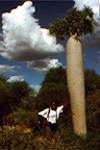 2.
2.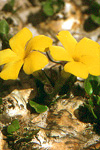 3.
3.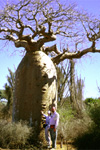 4.
4.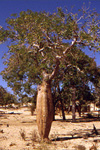 5.
5.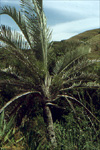 6.
6.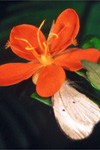 7.
7.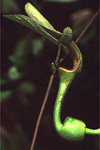 8.
8.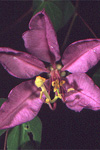 9.
9.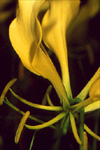 10.
10.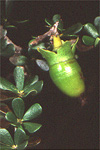 click for more
images.... potbellied palms, endemic Euphorbias, Alluaudia, Grewia,
Combretum, Bignoniaceae, Malpighiaceae, more Erblichia, palms,
grappling- hook fruit of Uncarina and baobabs!
click for more
images.... potbellied palms, endemic Euphorbias, Alluaudia, Grewia,
Combretum, Bignoniaceae, Malpighiaceae, more Erblichia, palms,
grappling- hook fruit of Uncarina and baobabs!
- 1. Missouri Botanical Garden
Student Sylvain Razafimandimbison with a large Pachypodium geayi,
a bottle tree member of the Oleander Family (Apocynaceae) in the southwest.
- 2. Pachypodium brevicaule
flowering in the central part of the island. Compare the habit of this
species of Pachypodium with the one in the previous photo. They
couldn't be more different: this one is a tiny tuber that barely reaches
above ground level while the other is a massive tree!
- 3. Big Adansonia rubrostipa
trees north of Tulear in the southwest.
- 4. Delonix decaryi
(formerly known as D. adansonioides ), a bottle tree
in the Legume Family (Fabaceae) that grows in the dry southwest.
- 5. The triangular palm
Neodypsis decaryi is perhaps more abundant in cultivation
than it is in habitat in the southeast.
- 6. Erblichia
sp. (Turneraceae) blooming in the Ankarana dry forest in the north.
- 7 A Dutchman's Pipe
(Aristolochia sp. in the Aristolochiaceae) in the Mikea Forest
on the west coast of the island.
- 8. A species of
Butterfly Tree or Orchid Tree in the genus Bauhinia sp. (Fabaceae)
in the Mikea Forest on the west coast of the island.
- 9. Gloriosa
sp., a member of the Lily Family (Liliaceae)in the
Mikea Forest on the west coast of the island.
- 10. A wild
species of the persimmon genus (Diospyros in
the Ebenaceae) in the Mikea Forest on the west coast of the island.
Animals
1.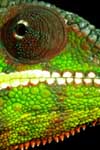 2.
2.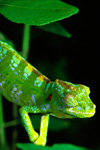 3.
3.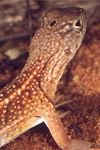 4.
4.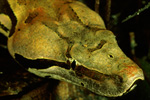 5.
5. 6.
6.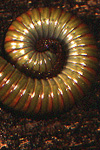 7.
7.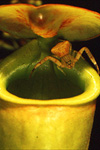 8.
8.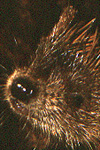 9.
9.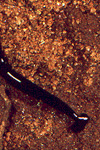 10.
10. click for more images
.... more chameleons, snakes, geckos, and millipedes!
click for more images
.... more chameleons, snakes, geckos, and millipedes!
- 1. The chameleon
Furcifer pardalis from the north.
- 2. Female
Furcifer labordi, a small chameleon from
the dry southern west coast.
- 3.
Chalarodon madagascariensis, an Iguana Family
lizard common in some dry areas.
- 4.
Acrantophis madagascariensis, a boa photographed
in the north.
-
5. A terrestrial, dry forest-dwelling crab found 100 kilometers from
the coast in northern Madagascar!
-
6. Big green millipede from northern dry forest.
-
7. Crab spider on the carnivorous pitcher plant Nepenthes madagascariensis
in a seep in the dry southeast. Crab spiders often perch on flowers
waiting to make meals of pollinating insects. This spider seems to be
waiting to steal a meal from the pitcher plant.
-
8. Tenrec in hollow Alluaudia tree in southeast.
-
9. Giant terrestrial planarian from southeastern dry forest crawling
on moist ground just after a rain.
-
10. Hissing cockroaches are common in dry forests throughout the island.
This one was in the west and measured over 7 cm long.
People and landscapes
-
1.
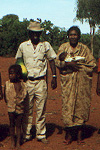 2.
2.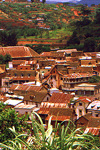 3.
3.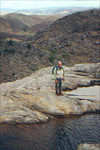
-
1. Remanonzo, a local guide who helped me collect Moringa in southeastern
Madagascar. He is shown here with one wife and their 10 children.
-
2. View of the capital, Antananarivo, from the Missouri Botanical Garden
office there.
-
3. View of the Itremo region of central southern Madagascar. This area
is characterized by dry quartz outcrops with many endemic plants and deep
canyons that shelter relict fragments of once-larger forests. The person
in the photo is A. Davis, a yodeling champion from Turkey.
-
home - people -
research - images of the dry
tropics - exploration -
acknowledgements
Instituto de Biología, Universidad Nacional Autónoma
de México
Circuito Exterior s/n, Ciudad Universitaria
Copilco, Coyoacán A. P. 70-367
C. P. 04510, México, D. F.
MÉXICO
(52) 55 5622-9127 fon (52) 55 5555-1760 fax
molson@ibiologia.unam.mx
all material © 2002 Mark E Olson
except Ifaty baobas and Delonix which are © 1999 Sylvain G
Razafimandimbison
and Itremo region which is ©1999 Simon T Malcomber
 2.
2. 3.
3. 4.
4. 5.
5. 6.
6. 7.
7. 8.
8. 9.
9. 10.
10. click for more
images.... potbellied palms, endemic Euphorbias, Alluaudia, Grewia,
Combretum, Bignoniaceae, Malpighiaceae, more Erblichia, palms,
grappling- hook fruit of Uncarina and baobabs!
click for more
images.... potbellied palms, endemic Euphorbias, Alluaudia, Grewia,
Combretum, Bignoniaceae, Malpighiaceae, more Erblichia, palms,
grappling- hook fruit of Uncarina and baobabs!









 2.
2. 3.
3.